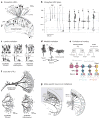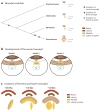Generation and Evolution of Neural Cell Types and Circuits: Insights from the Drosophila Visual System
- PMID: 28961025
- PMCID: PMC5849253
- DOI: 10.1146/annurev-genet-120215-035312
Generation and Evolution of Neural Cell Types and Circuits: Insights from the Drosophila Visual System
Abstract
The Drosophila visual system has become a premier model for probing how neural diversity is generated during development. Recent work has provided deeper insight into the elaborate mechanisms that control the range of types and numbers of neurons produced, which neurons survive, and how they interact. These processes drive visual function and influence behavioral preferences. Other studies are beginning to provide insight into how neuronal diversity evolved in insects by adding new cell types and modifying neural circuits. Some of the most powerful comparisons have been those made to the Drosophila visual system, where a deeper understanding of molecular mechanisms allows for the generation of hypotheses about the evolution of neural anatomy and function. The evolution of new neural types contributes additional complexity to the brain and poses intriguing questions about how new neurons interact with existing circuitry. We explore how such individual changes in a variety of species might play a role over evolutionary timescales. Lessons learned from the fly visual system apply to other neural systems, including the fly central brain, where decisions are made and memories are stored.
Keywords: cell fate; development; evolution; neural diversity; neuropil evolution; temporal series.
Figures




Similar articles
-
Drosophila R8 photoreceptor cell subtype specification requires hibris.PLoS One. 2020 Oct 14;15(10):e0240451. doi: 10.1371/journal.pone.0240451. eCollection 2020. PLoS One. 2020. PMID: 33052948 Free PMC article.
-
Tumor suppressor gene OSCP1/NOR1 regulates apoptosis, proliferation, differentiation, and ROS generation during eye development of Drosophila melanogaster.FEBS J. 2015 Dec;282(24):4727-46. doi: 10.1111/febs.13528. Epub 2015 Oct 27. FEBS J. 2015. PMID: 26411401
-
Lessons about terminal differentiation from the specification of color-detecting photoreceptors in the Drosophila retina.Ann N Y Acad Sci. 2013 Jul;1293:33-44. doi: 10.1111/nyas.12178. Epub 2013 Jun 19. Ann N Y Acad Sci. 2013. PMID: 23782311 Review.
-
An RNAi screen for secreted factors and cell-surface players in coordinating neuron and glia development in Drosophila.Mol Brain. 2020 Jan 3;13(1):1. doi: 10.1186/s13041-019-0541-5. Mol Brain. 2020. PMID: 31900209 Free PMC article.
-
FLPing Genes On and Off in Drosophila.Methods Mol Biol. 2017;1642:195-209. doi: 10.1007/978-1-4939-7169-5_13. Methods Mol Biol. 2017. PMID: 28815502 Free PMC article. Review.
Cited by
-
Analysis of a cellular structure observed in the compound eyes of Drosophila white; yata mutants and white mutants.Biol Open. 2020 Jan 13;9(1):bio047043. doi: 10.1242/bio.047043. Biol Open. 2020. PMID: 31862863 Free PMC article.
-
The Slit-Robo signalling pathway in nervous system development: a comparative perspective from vertebrates and invertebrates.Open Biol. 2025 Jul;15(7):250026. doi: 10.1098/rsob.250026. Epub 2025 Jul 9. Open Biol. 2025. PMID: 40628293 Free PMC article. Review.
-
Phenotypic Convergence: Distinct Transcription Factors Regulate Common Terminal Features.Cell. 2018 Jul 26;174(3):622-635.e13. doi: 10.1016/j.cell.2018.05.021. Epub 2018 Jun 18. Cell. 2018. PMID: 29909983 Free PMC article.
-
Establishment and maintenance of motor neuron identity via temporal modularity in terminal selector function.Elife. 2020 Oct 1;9:e59464. doi: 10.7554/eLife.59464. Elife. 2020. PMID: 33001031 Free PMC article.
-
New regulators of Drosophila eye development identified from temporal transcriptome changes.Genetics. 2021 Apr 15;217(4):iyab007. doi: 10.1093/genetics/iyab007. Genetics. 2021. PMID: 33681970 Free PMC article.
References
-
- Ammer G, Leonhardt A, Bahl A, Dickson BJ, Borst A. Functional specialization of neural input elements to the Drosophila ON motion detector. Curr Biol. 2015;25(17):2247–53. - PubMed
-
- Arendt D. The evolution of cell types in animals: emerging principles from molecular studies. Nat Rev Genet. 2008;9(11):868–82. - PubMed
-
- Arendt D, Musser JM, Baker CVH, Bergman A, Cepko C, et al. The origin and evolution of cell types. Nat Rev Genet. 2016;17(12):744–57. - PubMed
Publication types
MeSH terms
Substances
Grants and funding
LinkOut - more resources
Full Text Sources
Other Literature Sources
Molecular Biology Databases

